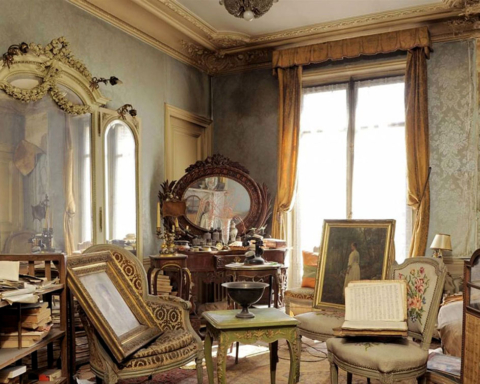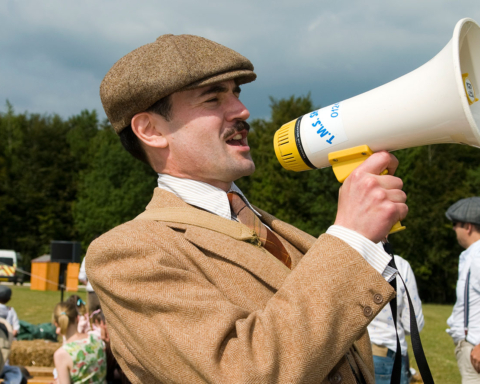Nathaniel Adams:
Our message,” says Peter McGough, “is about history and time and the trap of the calendar.” Since the 1970s, McGough and his partner David McDermott have been living in the past. Under the name McDermott and McGough, they have been making art – painting, performance, film, photography – about time. In those early years they were a conspicuous fixture on the Downtown New York City art scene, along with the likes of Andy Warhol, Jean-Michel Basquiat and Julian Schnabel. But McDermott and McGough didn’t just take old wet plate photographs and stretch and prime their own canvases with rabbit skin glue (although they certainly did do that), they also lived in a ‘time bubble’ of their own making.
“It’s abysmal for most of society to be forced by circumstances to live in the present, which doesn’t have depth to it. The present is quite superficial.”
The pair moved into a tenement on the Bowery across from a homeless shelter and restored their apartment to the way it was when first built – finding antique furniture in the garbage; building an old-fashioned mantelpiece out of a police barricade they found and dragged home from Avenue A, tearing out all of the electrical wiring and living by candlelight without heating, using original wooden toothbrushes with boar’s hair bristles – even going so far as to fill old toothpaste tubes with new toothpaste.
The young nobly starving artists with no more than two pennies to rub together were thin enough to fit into the 14½-inch detachable collars they found in junk shops. They had two suits from the 1930s, two shirts, two ties and two pairs of shoes between them, which they mixed and matched to create the illusion of a much larger wardrobe. They walked the streets of Greenwich village in battered top hats and grubby spats, wallpapered their ramshackle apartment with Victorian-revival wallpaper from the 1930s (which they bought for a dollar a roll), refused to get ordinary jobs, and attended Christian Science services because the religion hadn’t changed since its founding in the 19th Century.

Their motto was ‘I’ve seen the future and I’m not going’. “It is quite abysmal for most of society to be forced by circumstances to live in the present,” says David McDermott. “The present doesn’t have depth to it. It’s quite superficial.”
The pair’s efforts didn’t go unnoticed for long. When the uptown galleries ‘discovered’ the downtown art scene, the handsome masters of the anachronistic were celebrated, wondered over and mobbed by the press. “We were good copy,” says McGough, “We looked great, we had something intelligent to say, we had our art.”
With the recognition came McDermott and McGough’s first financial success. The art boom of the 80s and 90s was good to them, and they put their money back into their art. The costumes got more elaborate: they grew their hair out and dressed as period-perfect incroyables for a ball in Vienna; they bought a 1913 Model T Ford and had their mutual boyfriend, dressed as a chauffeur, drive them around the city. As their success continued and their coffers overflowed, they took their time experiments further, buying a colonial farmhouse in upstate New York, removing all the electricity, plumbing, and heating, and replacing the car with a horse-drawn carriage.

And then the crash came. The art market bottomed out and the boys were suddenly broke. To top it off, one of their more elaborate projects got them into a rather big spot of trouble. McDermott and McGough had put out an edition of their own newspaper using old-fashioned printing methods. The paper covered current events but was written in an old-fashioned way. One of the articles, covering a murder in a Washington DC Park, implied that an employee of the United States government was somehow involved. McDermott and McGough sent copies of the paper to the Pentagon and several senators. Despite the old-timey writing, Uncle Sam was not amused. Their phone was tapped, a black car was parked outside their studio each day, and the IRS suddenly took an undue interest in their tax statements.
Eventually the pressure got to be too much and the duo moved to Dublin. McDermott ultimately settled in Ireland, where he remains to this day, still wearing his detachable collars and cuffs (and missing an eye from a wood-chopping accident involving a stray flying chip). McGough moved back to New York and updated his era by a few decades, living in a perfect 1930s apartment.
But McDermott and McGough are far from idle these days. They continue to make art under the same name, even though the two are rarely in the same room together, and there’s been a revival of interest in their work. Their most recent major exhibition, Suspicious of Rooms Without Music or Atmosphere, features photo-realistic paintings of still frames from black and white movies, in which the heroine bears an expression of intense emotion, and their latest abstract paintings are based on vintage dress patterns, laid over one another on a canvas in various colours. And, most importantly of all, their theories of time are no less radical and uncompromising than they were. McDermott explains their beliefs and aims:
“Most people do not need to live in the present. We’re forced to live in a contemporary year or decade, which is constantly being destroyed by the society. I have a term for it and I call it ‘corporate time.’ We live in corporate time. Everything has to do with these products that are produced by corporations. The whole concept of moving forward in time is an old-fashioned and out-of-date and un-futuristic concept. There’s nothing modern about it – the idea of having a New Year and destroying the old year and forcing the creation of a new culture for the New Year. Because it really is quite forced.”
McDermott begins to outline the roots and symptoms of the problem: “I think modernism is a terrible, heinous, evil culprit. It’s definitely the excuse – modernism – for destroying the quality of life everywhere. I look at these housing developments here in Ireland. Two thousand of these concrete houses. And I look at them and I think, ‘What can the quality of life be here?’ And they each have their car and they drive off to some shopping mall which is basically the centre of their whole being – the shopping mall. That’s where they experience the present. And they buy the products and they bring them back to these horrible houses. These houses are deadly.”
McDermott’s solutions might strike some as extreme or pointless: “I look at [these housing developments] and I think the answer is the Tudor period. The only thing you could do with these houses is do them up in the Tudor style. I’m not just saying a few boards up at the cornice. I’m saying really over-do them based on the historical Tudor houses.”
“What’s the point of restoring 18th century houses if you don’t have 18th century people to live in them? There really isn’t a point”
The ideas for large-scale time experiments don’t end there: “Ideally, all times should exist at the same time. If we have a situation where we have all time existing at the same time, that’s more of a futuristic concept than the old fashioned concept of moving from year to year. Cities should be divided up into different time periods. In the countryside one would experience different time periods in different parts of the countryside. It would be interesting for a modern building company or a modern architectural company to design an 18th Century slum with all the twisting little streets and all the crooked little houses with floors that were not level, but it would all be made fire-proof. It would all be made so it wasn’t dangerous. But all the good parts about living in that kind of 18th Century French Kasbah would be there for young people to grow up in, rather than growing up in a project tower.”
And McDermott and McGough’s ideas go far beyond those of the typical interior decorator or real estate agent: “What’s the point of restoring 18th Century houses if you don’t have 18th Century people to live in them?” Asks McDermott. “There really isn’t a point. I also think that old houses should never be modernised in any way. If when the house was built it didn’t have electricity I don’t think there should be any electricity or central heating put into that house. When people buy a house from 1880, that house should be restored perfectly to 1880 – they are the custodians of that. I don’t see why this corporate culture can’t continue to evolve underwater, at the bottom of the sea or on another planet. But I really think it’s vulgar to take an 18th Century city and demolish it or just snake it with contemporary technology.”
When asked about the potential benefits of modern technology, McDermott explains that he believes it has its place in the world – but it needs to remain behind closed doors. “I think that technology should not be prevalent. I don’t think it needs to be everywhere. There should be some technological trailer buried in the garden where they have all their technology, and it would save money because of the amount of money it costs to snake technology into these old houses. I believe that if you’re in the 18th Century and you’re terribly ill and the doctor comes forward – the bleeder – and he understands the only way this person’s going to be cured is for him to use contemporary technology, I don’t see anything wrong with putting him in a coffin, having a funeral, putting him in a vault, and then sneaking that vault away into some technological laboratory, where he receives his operation and is healed.”










